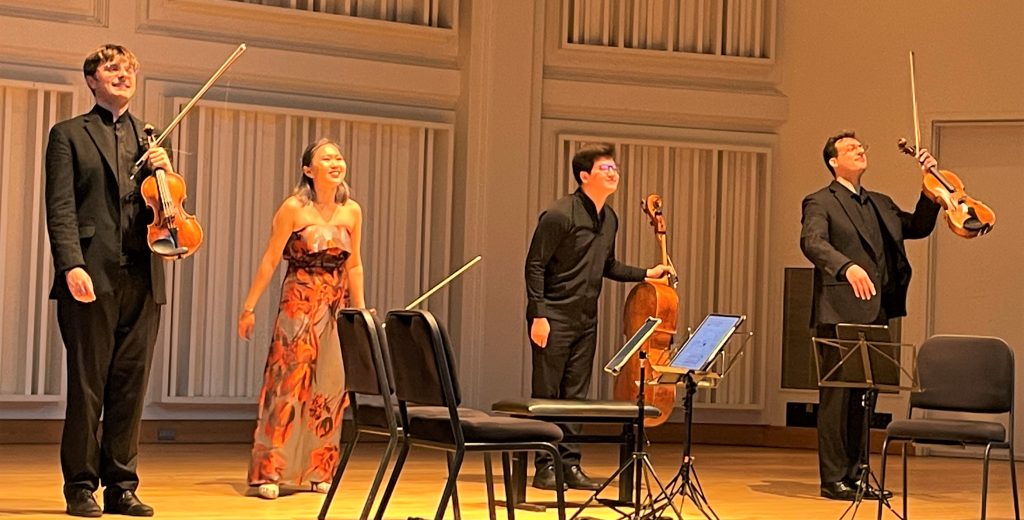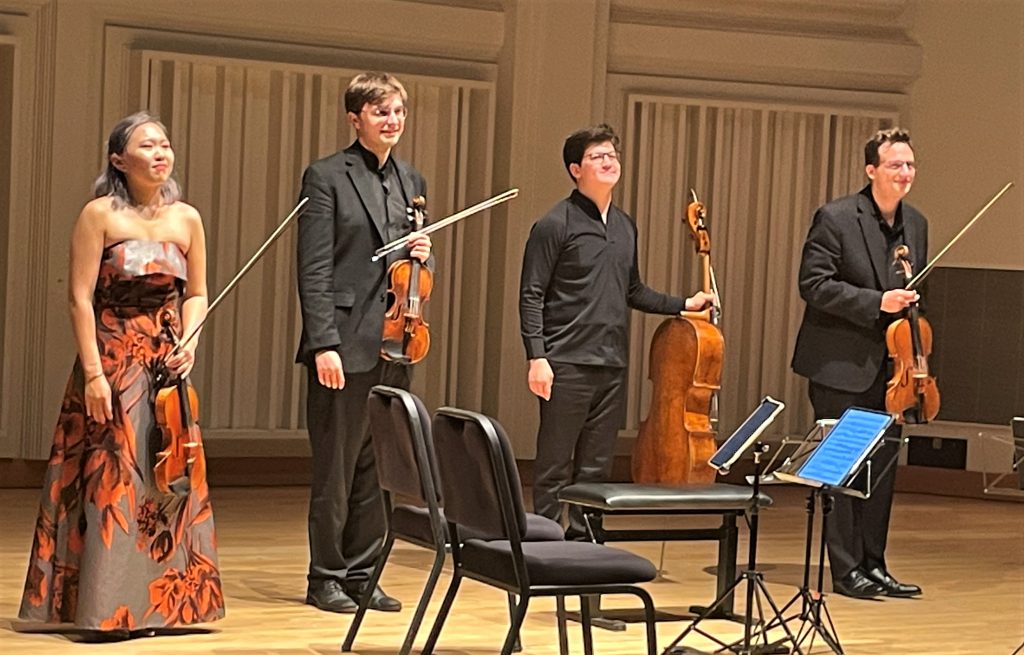
by Kevin T McEneaney
The quartet is named after the noted chef Antoine Baldourdet at the Taos Music School in New Mexico with whom they bonded over music and food. They opened with String Quartet in D Minor, K. 421 (1783) by Wolfgang Amadeus Mozart (1756-1791). This work is not often performed, often nicknamed the “Second Haydn Quartet,” written when Mozart briefly studied under Haydn who approved the composition.
This composition relates to the birth of Wolfgang and Constanze’s first child. Mozart composed the opening Allegro in anticipation of the birth of his first child. There is muted excitement and suspense in the first movement, especially from Defilipps on first violin.
I have twelve books on Mozart, but only Jan Swafford’s 2020 biography of Mozart speaks of the setting. Late in life, Constanze wrote a letter to a friend saying that the second movement was written in the bedroom during the days before birthing while Constanze lay helpless in bed attended by the midwife.
This second movement Andante, slightly Haydnesque, was so warm, and loving that I wanted to hear it again. This movement was remarkably tender, dramatizing the tender care Constanze was receiving from the midwife and Wolfgang. Russell Houston’s cello was so tender that I fell in love with the cello and Benjamin Zannoni’s viola floated such light-hearted serenity that I was captivated and prepared for any caprice. The Scherzo rejoiced for the successful delivery, although the labor was long and bloody. There is a puckish celebration with slow, meditative descent, perhaps a forward-looking anticipation of Raimond’s first steps.
The following Minuet offered the concluding Allegretto, a delightful dance summation of all is well, whereby the writing may have acted as a tonic that cured the composer of a long-standing cold. (Wolfgang had stopped drinking during the birthing and recovery of Constanze.) On second violin, Angela Bae carefully assisted that calm transition back to reality at the conclusion with a quick, joyous pace created through the addition of an extra note that repeated a triplet motif from the first movement. DeFilippis on first violin enunciated some high notes which portrayed the joyful comedy of the baby crying for food or attention. Attention to the baby was a mutual caring minuet. Mozart was the prince of charm, and this composition was such a delight with the intertextual weaving of instruments!
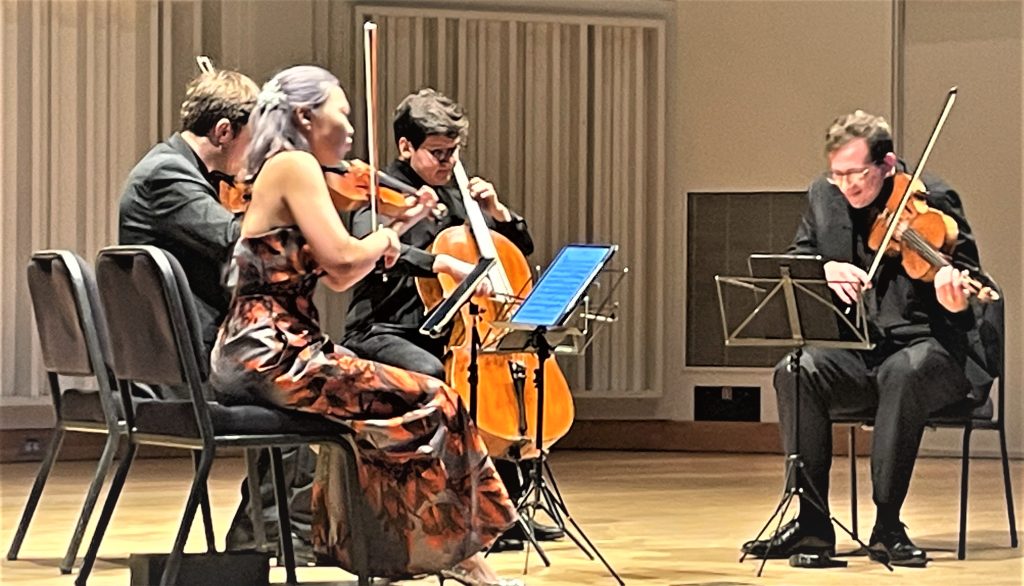
Strange Machines (String Quartet #4) by Karim Al-Zand (b. 1970) who teaches at Rice University is a clever, humorous piece inspired by the computer game Geometry Dash (2013) and its subsequent multiple versions), which offers musical sounds and images through algorithms (great for elementary school children!). Here we have a musical portrait of Leon Battista Alberti (1404-72), an architect, poet, priest, historian, philosopher, linguist (he wrote the first Italian grammar), and the inventor of cryptography! Here the music careens about, depicting the many angles of this legendary genius.
Alberti was deeply influenced by Alhazen Ibn Al-Haytham (d. c. 1041), an important Arab polymath. The work concludes with the sound of a wind-up toy whining downward. The music is the auditory version of a J. S. Bach-like jigsaw puzzle, employing fragments from J. S. Bach’s music. Goldberg Machine, the second movement, inspired by Bach’s 30 Goldberg Variations, appropriates many fragment snippets from that work, re-arranging them wittily into something that sounds like an amusing Rube Goldberg contraption machine which ultimately collapses from exhaustion.
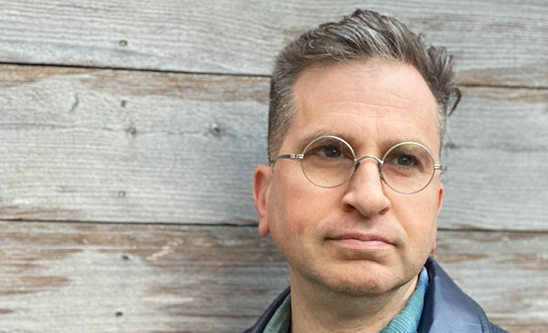
Mannheim, the third movement, presents fragments from Bach’s Mannheim period and mixes them with fragments from the contemporary American musical group Mannheim Steamroller produced by pianist and composer Chip Davis. Mannheim Steamroller refers to a German waltz technique of a crescendo passage having a rising melodic line over an ostinato bass line, popularized by the Mannheim school of composition. The finale sounded like a steam pump collapsing. Each of the three comical movements of Strange Machines featured an odd and amusing doubling motif which will thematically connect with Rameau’s doubling motifs later in the concert. To introduce an exciting, substantial work of humor amid a program of serious works indicates exemplary panache.
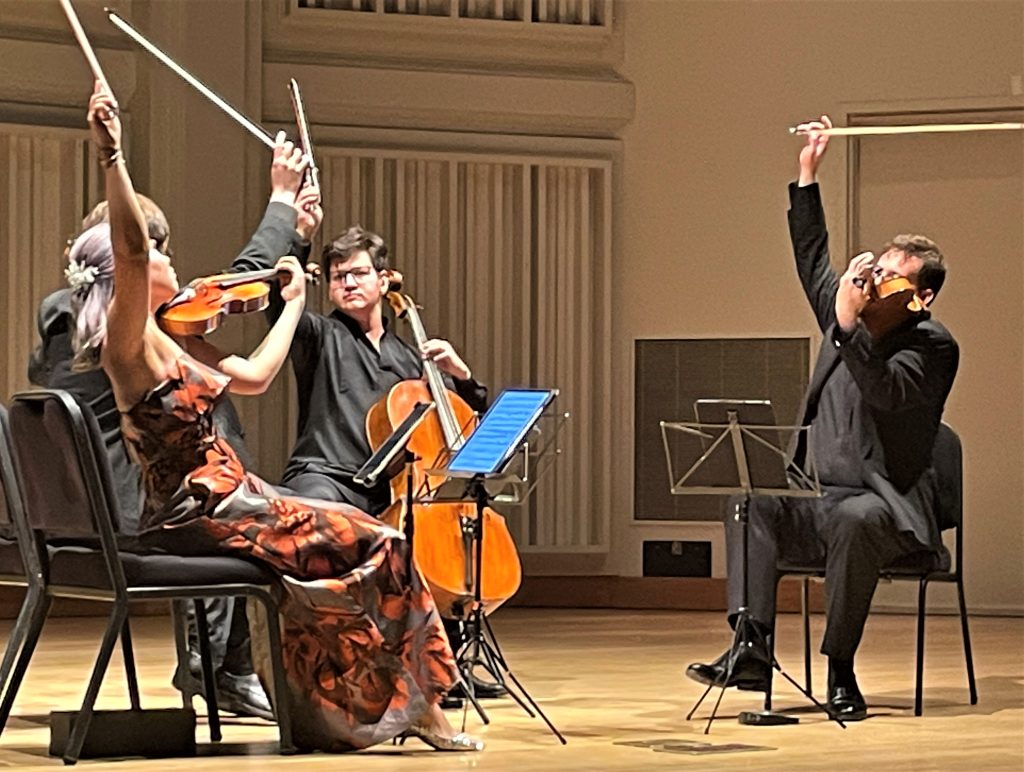
After intermission String Quartet in F Major, Op. 59 # 1 (1806) by Ludwig van Beethoven was performed. This was the first of three “symphonic quartets” commissioned by Count Razumovsky, the Russian ambassador to Vienna. Beethoven began working on the first of the three compositions on the day after his brother Carl’s marriage to a woman Beethoven despised (she was five months pregnant, nineteen years old from the middle class). Each of the three quartets was to employ a Russian melody. In the previous year, Beethoven had acquired a large three-volume anthology of Russian folk tunes and was eager to work with it; he was entering a rapturously productive period putting his brain on the cusp of insanity. (Many musicians are more rational in their work than in life.)
The first of these three quartets is the longest; all three are in sonata form. The first quartet promises to be a sequential continuation from the Eroica, beginning with some notes from its finale. For this performance, Angela Bae assumed the role of first violinist. The opening cello melody is entrancingly ambiguous and finally settles into F Major, then initiates a long captivating fugue as if Beethoven was proving that he could outdo Bach in that genre. The interweaving instruments of the four players were astonishing in the opening Allegro. The delay in recapitulation adumbrates what will happen in the climatic finale.
This second movement, Scherzo, is lively, unconventional, and considered Beethoven’s greatest scherzo, displaying an integration of extreme themes, which was handled with amazing ease here with the two violins offering contrasting development with cunning intricacy. The slow third movement Adagio presents a mournful aspect; it is the longest and most complex slow movement that Beethoven had written since his funeral march in his Eroica. Here the musicians on stage were tightly together as they invoked palpable melancholy.
The fourth movement offers the Russian melody in double time. The folk tune is a soldier’s lament on his return from war. (Stravinsky may have gotten his idea for A Soldier’s Tale from this movement.) The presentation of this melody has definite intervallic relationships to the first and third movements. There were more crescendos than I could count on my right hand and this delaying (as well as integrating) motif became an experience that created rapture at the conclusion where all four players seemed to exceed collectively their mutual abilities. This was contagious joy, but what was the direction of that joy? I imagine peace and love!
